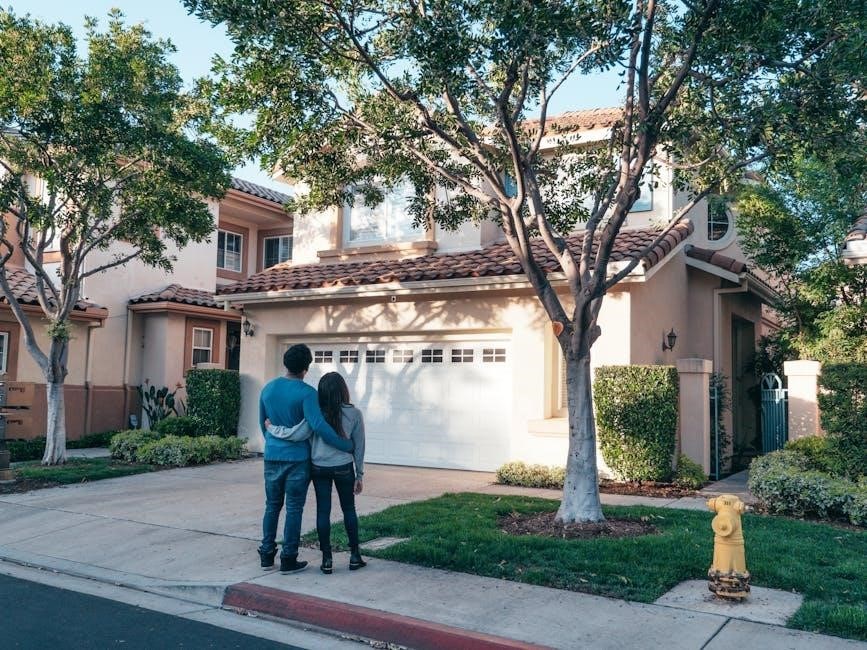Welcome to the Jaguar XJR Buyer’s Guide, your comprehensive resource for navigating the world of this iconic high-performance luxury sedan. This guide covers history, performance, maintenance, and buying tips to help you make an informed decision;
Overview of the Jaguar XJR
The Jaguar XJR is a high-performance variant of the XJ sedan, renowned for its powerful engines, luxurious interior, and refined design. Part of Jaguar’s esteemed lineage, the XJR combines classic British elegance with modern performance capabilities. Known for its supercharged engines and sport-tuned suspension, the XJR delivers a blend of power and sophistication. It has become a favorite among enthusiasts seeking a balance of style, comfort, and driving excitement. This guide provides insights into its history, performance, and ownership considerations, helping you make an informed decision.
Why Consider Buying a Jaguar XJR?
Consider the Jaguar XJR for its blend of luxury, performance, and timeless design. With a supercharged engine offering robust power, it delivers thrilling acceleration and a smooth ride. The XJR’s spacious interior, adorned with premium materials, ensures comfort for all passengers. Its classic styling turns heads, while advanced features provide modern convenience. Whether for daily driving or special occasions, the XJR offers a unique ownership experience, making it a compelling choice for those seeking a sophisticated yet powerful vehicle.

History of the Jaguar XJR
The Jaguar XJR traces its roots to the XJ series, emerging in 1994 as a high-performance variant under Ford’s ownership, blending power with elegance seamlessly.
Development and Launch of the XJR
The Jaguar XJR was first introduced in 1994 as part of the X300 generation, marking a significant milestone in Jaguar’s performance sedan lineup. Developed under Ford’s ownership, the XJR combined luxury with raw power, featuring a supercharged 4.0-liter straight-six engine producing 326hp and 378lb ft of torque. It debuted with sports suspension, a limited-slip differential, and distinctive styling cues such as 17-inch wheels. The XJR was positioned to rival high-performance saloons like the BMW M5, offering a blend of elegance and potency that stayed true to Jaguar’s heritage while appealing to enthusiasts seeking both comfort and speed.
Evolution of the XJR Across Different Generations
The Jaguar XJR evolved significantly across generations, with each iteration refining performance and luxury. The X300 (1994-1997) introduced the supercharged straight-six, while the X308 (1997-2003) switched to a V8 engine, enhancing power and refinement. Subsequent models incorporated advanced technology, improved interiors, and better handling, ensuring the XJR remained a formidable competitor in the luxury performance sector. Each generation maintained Jaguar’s hallmark blend of elegance and power, adapting to market demands while staying true to its high-performance roots.

Jaguar XJR Models and Specifications
The Jaguar XJR is available in various models, including the X300, X308, and X350, each offering distinct specifications, powerful engines, and refined features for discerning drivers.
X300 Generation (1994-1997)
The X300 generation marked the debut of the Jaguar XJR, offering a blend of luxury and performance. Powered by a supercharged 4.0L straight-six engine, it delivered 326hp and 378lb ft of torque. Key features included sports suspension, a limited-slip differential, and 17-inch wheels. Most models came with an automatic GM 4L80-E transmission. The X300 XJR could accelerate from 0-60mph in 6.6 seconds, with an electronically limited top speed of 155mph. Rust and maintenance issues are common, so buyers should inspect for corrosion and ensure proper servicing history.
X308 Generation (1997-2003)
The X308 generation introduced the V8-powered XJR, featuring a 4.0L supercharged engine producing 370hp and 387lb ft of torque. It retained the luxury and performance heritage of its predecessor while offering improved comfort and technology. Available in both standard and long wheelbase versions, the X308 XJR boasted a refined interior and enhanced features. Performance remained strong, with a 0-60mph time of 5.9 seconds. Buyers should focus on models with thorough maintenance records, as common issues include electrical faults and supercharger-related concerns, which can be costly if neglected.
Key Differences Between Models
The Jaguar XJR models vary across generations, with the X300 (1994-1997) featuring a 4.0L supercharged straight-six engine, while the X308 (1997-2003) introduced a 4.0L V8. The X300 boasts a lighter chassis and more agile handling, whereas the X308 offers enhanced refinement and interior technology. Transmission options also differ, with the X300 using a heavy-duty GM 4L80-E automatic, while the X308 refined the gearbox for smoother performance. Exterior and interior styling evolved, with the X308 adopting more modern design cues and improved luxury features.

Performance and Capabilities
The Jaguar XJR delivers exceptional performance with its supercharged engine, offering rapid acceleration and a top speed of 155mph. Its powerful V8 and refined handling ensure a thrilling drive.
Engine and Supercharger Overview
The Jaguar XJR is powered by a robust 4.0-litre supercharged straight-six engine, known for its reliability and strength. Producing 326 horsepower and 378 lb-ft of torque, it delivers smooth yet potent performance. The Eaton M90 supercharger enhances power delivery, making it ideal for both cruising and spirited driving. Regular servicing is crucial, especially supercharger oil changes for high-mileage cars. Proper maintenance ensures longevity and optimal performance, making the XJR a reliable choice for enthusiasts seeking a balance of luxury and power.
Transmission and Handling
The Jaguar XJR features a durable GM 4L80-E automatic transmission, offering smooth shifts and reliable performance. Transmission fluid condition is crucial; clean, red fluid indicates good health, while dark or burnt fluid may signal issues. The XJR also boasts a limited-slip differential for enhanced traction. Handling is refined, though suspension components may show wear due to the car’s weight and age. Regular inspections of bushes and bearings are advised to maintain optimal ride quality and responsiveness.
Acceleration and Top Speed
The Jaguar XJR delivers impressive performance with its supercharged engine, achieving 0-60mph in just 6.6 seconds in automatic form. The top speed is electronically limited to 155mph, offering a blend of refined luxury and exhilarating power. This capability makes the XJR a standout in its class, providing a driving experience that balances comfort and thrilling acceleration. Whether cruising on the highway or accelerating from a standstill, the XJR’s performance is both responsive and refined, making it a compelling choice for enthusiasts seeking a powerful yet elegant sedan.

Common Problems and Maintenance Tips
The Jaguar XJR often faces rust issues, electrical faults, and engine concerns. Regular inspections of arches, screens, and mechanical components are crucial. Addressing these promptly ensures longevity and performance.
Rust and Bodywork Issues
Rust is a prevalent issue in the Jaguar XJR, particularly around the front and rear arches, screen edges, and sills. Regular inspections with a torch are essential to spot early signs of corrosion. Neglecting these areas can lead to costly repairs. Additionally, peeling or cracked lacquer on the bodywork is common if not properly maintained. Prospective buyers should check for mismatched panels and signs of accident damage, as these can indicate underlying structural issues. Addressing rust and bodywork problems early ensures the car’s longevity and visual appeal.
Electrical and Interior Faults
The Jaguar XJR often experiences electrical issues, such as faulty clock displays and auto-dimming rear-view mirrors leaking caustic fluid. Sagging headlinings are common, but replacements are affordable. Check all electronics, including mirrors, windows, and climate control, for proper function. The driver’s seat may show excessive wear, and minor components like air vents can malfunction. Addressing these issues early prevents costly repairs and ensures a comfortable, functional interior. A thorough inspection is essential to identify and resolve these potential problems before purchase.
Engine and Mechanical Concerns
The supercharged 4.0-litre AJ16 engine in the Jaguar XJR is generally robust but requires proper servicing. Issues like gummed throttle shafts and supercharger noise can arise, often resolved with cleaning. Coolant leaks and exhaust manifold cracks are common, needing timely attention. Regular maintenance, such as supercharger oil changes, is crucial. While major failures are rare, neglect can lead to costly repairs. Inspect the exhaust system for cracks and ensure the transmission fluid is clean. Addressing these issues early ensures reliability and performance, making the XJR a satisfying ownership experience with proper care.

Upgrades and Modifications
The Jaguar XJR offers ample opportunities for upgrades, including engine enhancements, suspension improvements, and interior customizations. Popular modifications include crank sensor upgrades and supercharger pulley tweaks for boosted performance. Additionally, suspension refreshes and bespoke interior trim options allow owners to tailor their XJR to personal preferences, blending luxury with enhanced capabilities. These upgrades not only elevate performance but also preserve the car’s classic appeal, making ownership even more rewarding.
Popular Upgrades for the XJR
Popular upgrades for the XJR include supercharger pulley modifications to increase boost pressure, resulting in enhanced power output. Engine tuning and revised crank sensor brackets are also sought after for improved performance. Suspension upgrades, such as stiffer springs and dampers, enhance handling without compromising comfort. Interior customizations, like bespoke trim and upholstery, allow owners to personalize their car. Additionally, lightweight alloy wheels and high-performance tires improve both aesthetics and driving dynamics, making the XJR a formidable blend of luxury and agility.
Performance Enhancements
Performance enhancements for the XJR focus on maximizing its supercharged potential. Upgraded supercharger pulleys, intercoolers, and engine tuning can significantly boost power and torque. Lightweight alloy wheels with high-performance tires improve handling and responsiveness. Modifications to the exhaust system enhance sound and reduce backpressure, while engine cooling upgrades ensure reliability under increased demand. These enhancements transform the XJR into a more agile and powerful machine, blending luxury with heightened performance capabilities, making it a standout choice for enthusiasts seeking both style and speed.
Interior and Exterior Customization
Customizing the XJR allows owners to tailor its luxury and performance to their preferences. Interior upgrades include bespoke leather upholstery, wood trim, and modern infotainment systems. Exterior modifications can enhance the car’s aggressive stance with aerodynamic kits, alloy wheels, and unique paint finishes. Owners can also add vintage or modern styling elements, such as chrome accents or carbon fiber components. These customizations preserve the XJR’s classic appeal while adding a personal touch, making each car truly unique and reflective of its owner’s style.

Buying Tips and Inspection Checklist
Inspect for rust, especially in arches and sills. Check electrical systems, supercharger, and coolant hoses. Review maintenance records and test drive thoroughly to avoid costly surprises later.
What to Look for When Inspecting a Used XJR
When inspecting a used Jaguar XJR, focus on key areas like rust in the arches, sills, and engine bay. Check for peeling lacquer and panel alignment. Inside, inspect the headlining, electronics, and seat condition. Test the supercharger for unusual noises and ensure coolant hoses are intact. Look for signs of leaks or damage in the exhaust system. Verify the transmission fluid condition and listen for odd noises during the test drive. A thorough inspection can help avoid costly surprises and ensure a reliable purchase.
Negotiation and Pricing Strategies
When negotiating the price of a used Jaguar XJR, research market values based on model year, mileage, and condition. Prices for earlier models (1994-1997) typically range from $11,660 to $19,800, while later models (1997-2003) may be slightly higher. Highlight any needed repairs, such as rust issues or worn interiors, to secure a better deal. Use the car’s unique features, like the supercharged engine, to justify your offer. Aim for a balance between performance and luxury, ensuring the final price reflects the car’s true value and condition.
Test Drive and Pre-Purchase Inspection
A thorough test drive is essential to assess the Jaguar XJR’s performance and condition. Check for smooth acceleration, responsive handling, and any unusual noises. Inspect the exterior for rust, particularly around arches and sills, and examine the interior for worn seats or faulty electronics. Test all features, including climate control and the stereo. A pre-purchase inspection by a specialist is highly recommended to identify hidden issues. This step ensures you understand the car’s true condition before finalizing the purchase and can negotiate repairs or pricing accordingly.
Owning a Jaguar XJR offers a perfect blend of power, luxury, and heritage. With proper care, it promises years of driving satisfaction and pride of ownership.

Final Thoughts on Owning a Jaguar XJR
Owning a Jaguar XJR is a rewarding experience that combines luxury, power, and heritage. Its supercharged performance and elegant design make it a standout choice for enthusiasts. While maintenance requires attention to rust and mechanical components, the XJR offers a blend of classic charm and modern capabilities. With proper care, it can be a reliable and enjoyable companion for years, providing a unique balance of comfort and exhilaration on the road.
Is the XJR the Right Car for You?
The Jaguar XJR is ideal for those seeking a blend of power, luxury, and classic appeal. It suits enthusiasts who value high performance and comfort, making it perfect for both daily driving and special occasions. However, consider maintenance costs and mechanical care. If you appreciate a refined yet potent vehicle with timeless styling, the XJR is a compelling choice. Weigh your needs against its unique offerings to decide if it aligns with your lifestyle and preferences.
